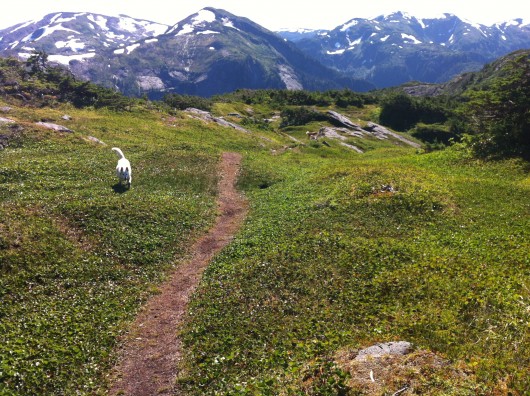
Dude Mountain Trail is one of the trails that would not be funded through the proposed Forest Service niche funding strategy.
Most people who choose to live in Southeast Alaska are here, at least in part, because of the forest. We hike trails that take us through dense rainforest or into alpine meadows; we boat out to a remote cabin in order to fish, hunt, or just get away from civilization for a few days.
But those resources cost money to maintain. That money has dwindled over the past few years, and now U.S. Forest Service officials are faced with some tough choices: What trails, cabins, etc., will get funded? What will be allowed to slowly deteriorate until it’s no longer useable? And is there a third choice: citizen volunteers who care enough to take up some of the slack?
The Ketchikan-Misty Fiords Ranger District led a public-information meeting Thursday on the issue.
First a quick rundown on how the Forest Service budget works. There are various pots of money, the largest coming from Congress. That congressional funding goes to the Washington, D.C., office, then filters down through the ranks until it gets to the districts. But, that money comes with restrictions.
Here’s Clark Simpson, the Ketchikan district’s recreation program manager.
“You can’t just take money from timber and give it to recreation,” he said, giving an example. “When Congress allocates money to timber, they give it to timber to do timber sales. They don’t give it to timber to maintain trails. They’re pretty specific about where they want that money to go.”
And because Congress has chosen to cut the Forest Service recreation budget essentially in half over the past five years, Tongass National Forest officials had to figure out what they can continue to do.
Ketchikan’s District Ranger Jeff DeFreest explains that the Tongass Leadership Team got together to strategize.
“What we came out with is a niche strategy,” he said. “The idea is to look at the 10 districts on the Tongass and what they’re good at, what they’re known for, what their specialties are. When it comes down to reduced budgets and reduced services, where are we going to gather up, circle the wagons, what’s most important to a given place.”
For example, DeFreest said Prince of Wales Island has identified road-access recreation as one of its niches, because that island has so many roads compared to other places on the Tongass. And Juneau likely will pick the Mendenhall Glacier.
For Ketchikan, a designated niche is the Ward Lake recreation area – which is extremely popular with local residents and includes a fair number of well-used trails. Misty Fiords National Monument, a major destination for numerous summertime tourists, also was picked; as was the Hyder bear-viewing facility, unique because it’s accessible by road from the Lower 48.
An audience member asked why the district didn’t designate all trails on Ketchikan’s road system as one niche, because they’re all popular and well-used.
“Well, because we can only stretch those appropriated dollars so far,” DeFreest said. “When we went through and looked at what we could define as areas that we’re going to use those appropriated dollars on down to the last dollar, that’s what we came up with.”
Those leading the meeting spent a good chunk of time explaining the problem. Then, they started talking about potential solutions. DeFreest said everyone who uses the forest for recreation can help, even in a small way: Picking up trash along a trail, for example.
Simpson added that he’s put in a request to increase fees for cabins, which could help allow continued, albeit limited, maintenance. All cabin fees must be used for cabins, even if they’re not in a niche.
Another idea is a volunteer work crew. But, they have to be well-coordinated. Simpson said it wouldn’t be helpful if Forest Service personnel had to organize the volunteers.
“But I love the idea of volunteers, so if you as the public get a volunteer group together that’s really solid, and you have good leadership, we can work straight with that leader and we wouldn’t even have to be there necessarily half the time,” he said.
They’d just tell the crew: “Here’s a bunch of loppers, go out there and brush that trail.”
And then there’s what Simpson calls the “bake sale” approach to raising money: A foundation.
“If somebody was really motivated, you could get a foundation together – a Friends of the Tongass National Forest Recreation,” he said. “Basically, it would be like the rest of our money, you would have $50,000 you raised through the foundation and all the districts would say, ‘Hey, here’s our projects that we’d really like to see get done. We have the people that can do that job, so can you fund us for this project for the year.’”
There were no solutions established, no decisions made, no volunteer groups formed during the meeting. It was just the first step, a way to let people know what’s happening, and to spark ideas for how to help.
Simpson said the niche management concept likely will start next summer, so forest officials and forest users have about a year to figure things out.
Ketchikan was the first of 10 Tongass National Forest districts to nail down its three niches, according to forest Partnership Coordinator Travis Mason-Bushman. The other districts should have their niches defined by the week of May 12-16, and then will schedule their own public workshops on the issue.





